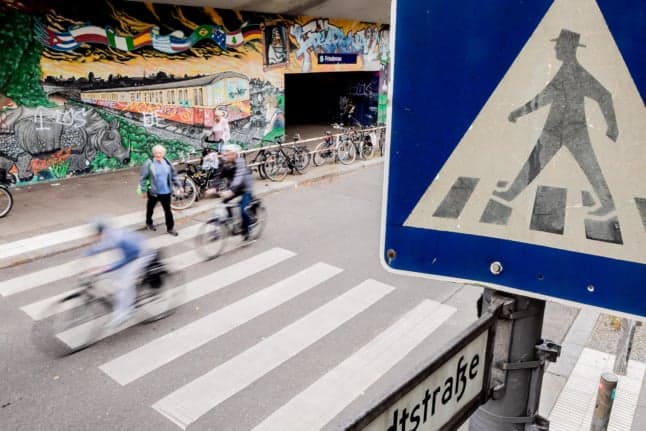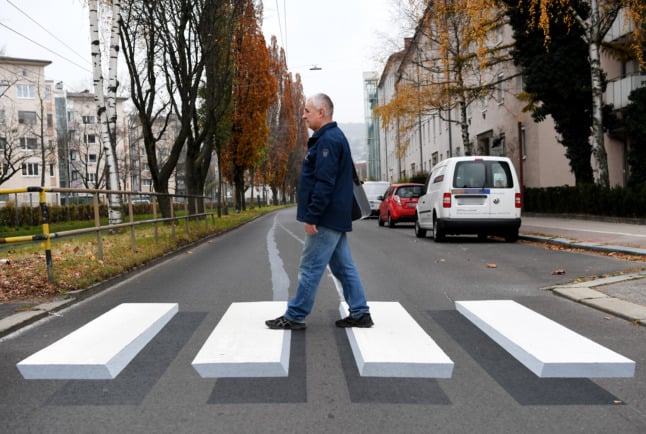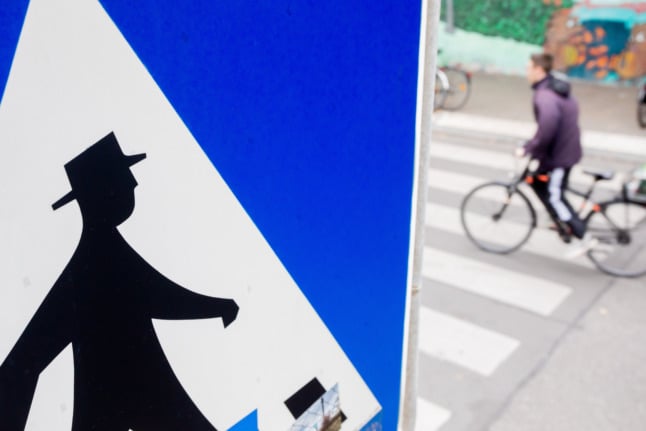Busting the myths around zebra crossings - the rocky rules of German roads

Ahead of Germany's 'Zebra Crossing Day' on September 1st, experts have busted some common myths about right of way on German roads. Here are the rules you'll need to bear in mind when encountering these hotly debated traffic zones.
The zebra crossing is a hot and disputed territory in Germany, with cyclists and motorists fiercely asserting their right of way.
It's a common scenario, especially in big cities: the cyclist, assuming the rights of the pedestrian, rides over the zebra crossing without hesitation and all the car drivers have to risk injury by braking to let them through. But is this allowed? Can the cyclist take on the rights of the pedestrian?
The Zebra Crossing: A British import
An English invention, zebra crossings became popular in Germany after accident statistics from the 1960s and 1970s showed that Germany had the highest number of childhood accidents in Europe.
They weren’t always the fine zebra-esque black and white that you see now, but used to resemble far more a bee or wasp, with alternating black and yellow stripes.
And whilst Germany has largely stuck to this blueprint, other places are branching out: one city in Spain has ‘cow crossings’ painted to resemble the hide of a cow, whilst Hong Kong has yellow ‘tiger crossings’ and countries like Australia, Iceland and New Zealand have developed “three dimensional” crossings which appear to levitate over the ground.
READ ALSO: Braunschweig could soon get Germany’s first ‘floating crosswalk’
The plan to prevent accidents using zebra crossings unfolded with varying results in Germany after zebra crossings were shown to be the scene of one fifth of road accidents in 2012. Researchers have identified widespread uncertainty about the rules regarding right of way at zebra crossings as one of the key factors in such statistics.

This 'floating' zebra crossing in Linz, Austria, was mimicked in Germany when the country created its first levitating crossing in Braunschweig. Photo: picture alliance / Fotokerschi.At/APA/dpa | Fotokerschi.At
In advance of the German ‘Zebra Crossing Day’ (1st September), experts have put together some myth-busting true or false statements for your consideration.
TRUE OR FALSE? Cyclists have the same rights as pedestrians on zebra crossings.
The answer is… false! Whilst pedestrians or wheelchair users take absolute precedence here - even if they are only nearing the zebra crossing - a cyclist on the pedestrian crossing has no claim to priority crossing.
“As a cyclist, you have to wait at the zebra crossing until the path is free,” explained representative of the General German Cycling Club, Roland Huhn.
And what if there’s an accident involving a cyclist on the zebra crossing? According to Anika Meenken, spokesperson for cycling at the Verkehrsclub Deutschland, the cyclist is more likely to take the blame than the larger vehicle involved.
READ ALSO: The German rules of the road that are hard to get your head around
TRUE OR FALSE? Cyclists are not even allowed to ride over the zebra crossing.
This is… false!
“Cyclists are allowed to ride over the zebra crossing,” explains Huhn. “They just don’t have any priority over any of the other vehicles on the street.”
What this means, he clarifies, is that “if a car has to stop or brake because of a moving cyclist on the crossing, the cyclist will risk a fine for an avoidable obstruction.”
TRUE OR FALSE? If you get off your bike and push it, you get right of way.
This is… true! “If you push your bike rather than riding it, you’re technically on foot so you get right of way,” Huhn explains.

Pushing your bike or using as a scooter, with one foot on the ground, can keep you on the right side of the law in pedestrian zones. Photo: picture alliance/dpa | Christoph Soeder
Meenken clarifies that you become a pedestrian the second you’re off your bike, even if you’ve still got the vehicle right by your side.
TRUE OR FALSE? If you use your bike like a scooter, you’ll technically become a pedestrian.
The answer to this one is… true! This bizarre outcome is the result of two court judgements in Berlin and Stuttgart. In the former case, a cyclist partly dismounted in front of a zebra crossing and started to use his bike like a scooter, resting one foot on the pedal and propelling himself forward with the other.
There was an accident at the crossing, but because the cyclist was not technically on the vehicle, the court ruled that he was not responsible.
For this reason, if you want first priority on the crossing you’re best off either walking your bike or using it like a scooter. Legal expert Huhn confirms this, saying “anyone who scoots on their bicycle whilst standing on a pedal is considered a pedestrian.”
TRUE OR FALSE? Children on bicycles have right of way on zebra crossings.
This is… false! When they are on their bicycles, children don’t actually have any priority in crossing. However, if they get off their bikes and push them on foot, they become pedestrians and have right of way. Huhn emphasises that logistically this will mean that drivers always have to wait if they see a child approaching the crossing, even if it isn’t ingrained in law.
READ ALSO: What you need to know about changes to German driving laws in 2021
Translated by Antonia Harrison
Comments
See Also
The zebra crossing is a hot and disputed territory in Germany, with cyclists and motorists fiercely asserting their right of way.
It's a common scenario, especially in big cities: the cyclist, assuming the rights of the pedestrian, rides over the zebra crossing without hesitation and all the car drivers have to risk injury by braking to let them through. But is this allowed? Can the cyclist take on the rights of the pedestrian?
The Zebra Crossing: A British import
An English invention, zebra crossings became popular in Germany after accident statistics from the 1960s and 1970s showed that Germany had the highest number of childhood accidents in Europe.
They weren’t always the fine zebra-esque black and white that you see now, but used to resemble far more a bee or wasp, with alternating black and yellow stripes.
And whilst Germany has largely stuck to this blueprint, other places are branching out: one city in Spain has ‘cow crossings’ painted to resemble the hide of a cow, whilst Hong Kong has yellow ‘tiger crossings’ and countries like Australia, Iceland and New Zealand have developed “three dimensional” crossings which appear to levitate over the ground.
READ ALSO: Braunschweig could soon get Germany’s first ‘floating crosswalk’
The plan to prevent accidents using zebra crossings unfolded with varying results in Germany after zebra crossings were shown to be the scene of one fifth of road accidents in 2012. Researchers have identified widespread uncertainty about the rules regarding right of way at zebra crossings as one of the key factors in such statistics.

This 'floating' zebra crossing in Linz, Austria, was mimicked in Germany when the country created its first levitating crossing in Braunschweig. Photo: picture alliance / Fotokerschi.At/APA/dpa | Fotokerschi.At
In advance of the German ‘Zebra Crossing Day’ (1st September), experts have put together some myth-busting true or false statements for your consideration.
TRUE OR FALSE? Cyclists have the same rights as pedestrians on zebra crossings.
The answer is… false! Whilst pedestrians or wheelchair users take absolute precedence here - even if they are only nearing the zebra crossing - a cyclist on the pedestrian crossing has no claim to priority crossing.
“As a cyclist, you have to wait at the zebra crossing until the path is free,” explained representative of the General German Cycling Club, Roland Huhn.
And what if there’s an accident involving a cyclist on the zebra crossing? According to Anika Meenken, spokesperson for cycling at the Verkehrsclub Deutschland, the cyclist is more likely to take the blame than the larger vehicle involved.
READ ALSO: The German rules of the road that are hard to get your head around
TRUE OR FALSE? Cyclists are not even allowed to ride over the zebra crossing.
This is… false!
“Cyclists are allowed to ride over the zebra crossing,” explains Huhn. “They just don’t have any priority over any of the other vehicles on the street.”
What this means, he clarifies, is that “if a car has to stop or brake because of a moving cyclist on the crossing, the cyclist will risk a fine for an avoidable obstruction.”
TRUE OR FALSE? If you get off your bike and push it, you get right of way.
This is… true! “If you push your bike rather than riding it, you’re technically on foot so you get right of way,” Huhn explains.

Pushing your bike or using as a scooter, with one foot on the ground, can keep you on the right side of the law in pedestrian zones. Photo: picture alliance/dpa | Christoph Soeder
Meenken clarifies that you become a pedestrian the second you’re off your bike, even if you’ve still got the vehicle right by your side.
TRUE OR FALSE? If you use your bike like a scooter, you’ll technically become a pedestrian.
The answer to this one is… true! This bizarre outcome is the result of two court judgements in Berlin and Stuttgart. In the former case, a cyclist partly dismounted in front of a zebra crossing and started to use his bike like a scooter, resting one foot on the pedal and propelling himself forward with the other.
There was an accident at the crossing, but because the cyclist was not technically on the vehicle, the court ruled that he was not responsible.
For this reason, if you want first priority on the crossing you’re best off either walking your bike or using it like a scooter. Legal expert Huhn confirms this, saying “anyone who scoots on their bicycle whilst standing on a pedal is considered a pedestrian.”
TRUE OR FALSE? Children on bicycles have right of way on zebra crossings.
This is… false! When they are on their bicycles, children don’t actually have any priority in crossing. However, if they get off their bikes and push them on foot, they become pedestrians and have right of way. Huhn emphasises that logistically this will mean that drivers always have to wait if they see a child approaching the crossing, even if it isn’t ingrained in law.
READ ALSO: What you need to know about changes to German driving laws in 2021
Translated by Antonia Harrison
Join the conversation in our comments section below. Share your own views and experience and if you have a question or suggestion for our journalists then email us at [email protected].
Please keep comments civil, constructive and on topic – and make sure to read our terms of use before getting involved.
Please log in here to leave a comment.